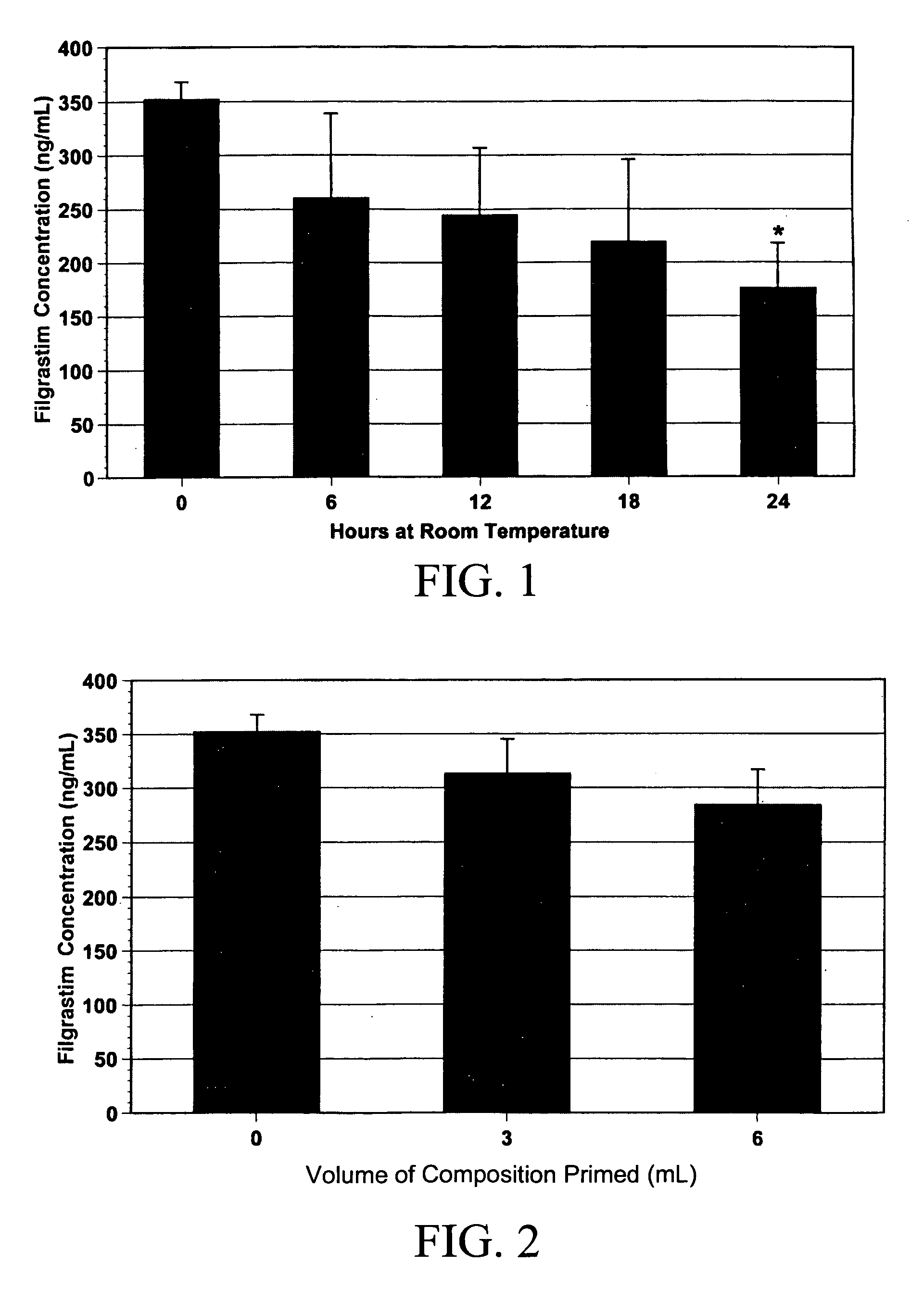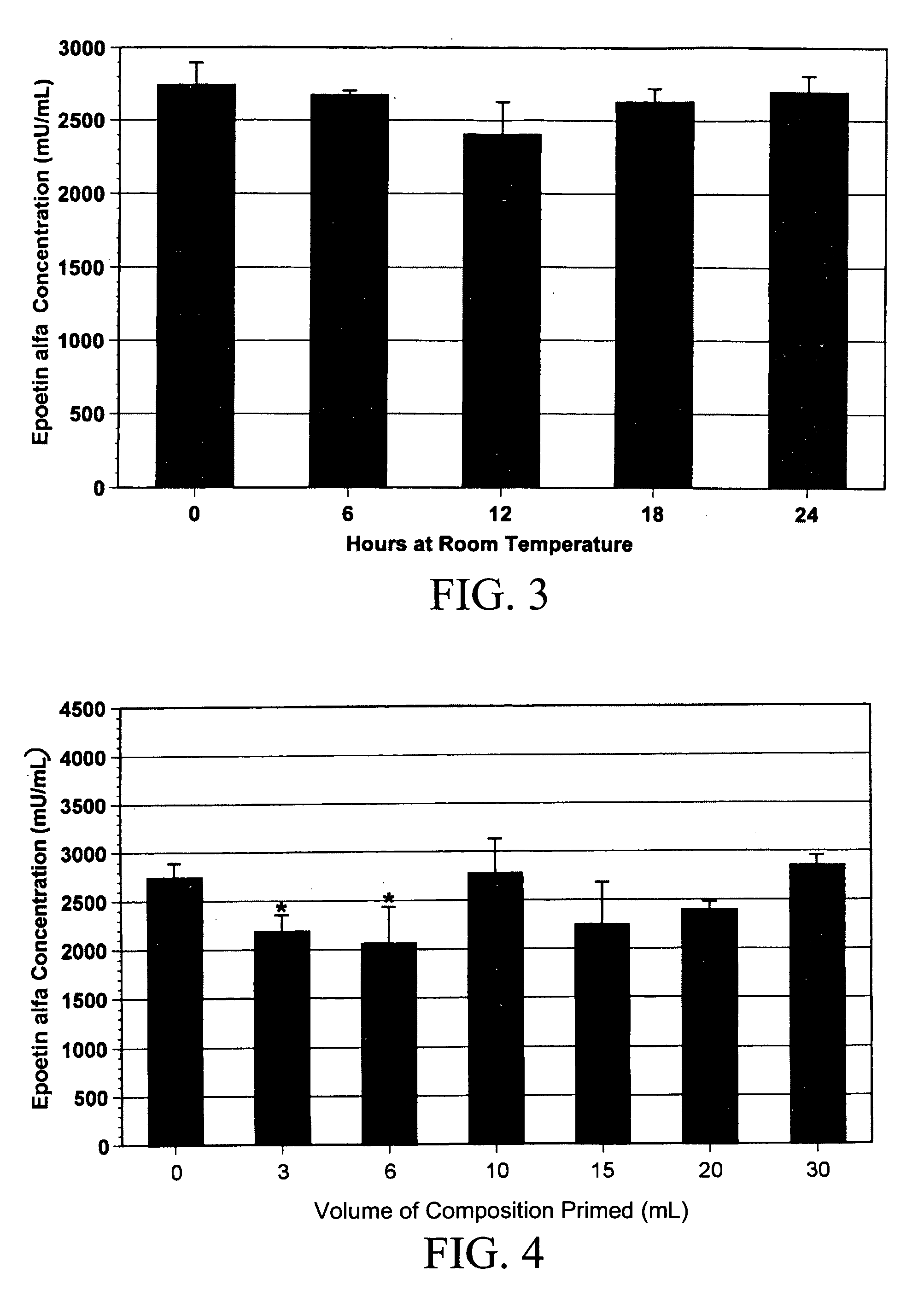Materials and methods for providing nutrition to neonates
a technology of nutrition and neonates, applied in the field of materials and methods for providing nutrition to neonates, to achieve the effects of promoting or facilitating nutritional intake, reducing or preventing villous atrophy, and feeding intoleran
- Summary
- Abstract
- Description
- Claims
- Application Information
AI Technical Summary
Benefits of technology
Problems solved by technology
Method used
Image
Examples
example 1
Stability of Recombinant Granulocyte-Colony Stimulating Factor
[0050]For the experiments described in Examples 1 and 2, filgrastim and epoetin alfa were added to a solution with NaCl 0.9%, sodium acetate, potassium chloride, and human albumin in concentrations designed to mimic human amniotic fluid. Additionally, the composition was dripped through polyvinyl chloride feeding tubes to simulate feedings, and aliquots were collected before, during, and after priming of the tube. Other aliquots were either frozen immediately, stored at room temperature, or refrigerated for 0, 6, 12, 18, and 24 hours. Filgrastim and epoetin alfa concentrations in the various aliquots were then compared with the concentrations in the original solution.
[0051]The measured concentration of filgrastim in the composition of the subject invention was consistently higher than the calculated value (measured, 352±16 vs. calculated, 225 ng / mL; n=5). The stability of filgrastim in the composition of the subject inven...
example 2
Stability of Recombinant Erythropoietin
[0052]The measured concentration of epoetin alfa in the composition of the subject invention was consistently lower than the calculated value (measured, 2860±185 vs. calculated, 4400 mU / mL; n=5). It was stable at room temperature for up to 24 hours, with no difference between freshly prepared solutions and room temperature-exposed solutions (2860±185 vs. 2695±134 mU / mL at time zero and at 24 hours, respectively; n=5 per group; FIG. 3). The solution was stable when frozen, with no further decrease in epoetin alfa concentration for up to three weeks. After freezing for one month, however, a slight but significant decrease in epoetin alfa concentration was noted (2860±185 vs. 2353±59 mU / mL, respectively; n=5; p<0.05). There was also a decrease in epoetin alfa concentrations after passing the solution through a polyvinyl chloride feeding tube (FIG. 4). The initial epoetin alfa concentration was 2742±152 mU / mL (n=12). After a 3-mL prime through the ...
example 3
Simulated Digestion
[0054]The susceptibility of filgrastim and epoetin alfa to degradation within compositions of the subject invention and within pooled human amniotic fluid was evaluated using neonatal gastric secretions as an in vitro simulation of neonatal digestion (Kling et al. [1998]Pediatr Res 43:216–21; Calhoun et al. [2001]Obstet Gynecol 97:229–34). Preterm gastric secretions were used exclusively. Simulations were run for 0 (baseline degradation), 1 hr, and 2 hrs. These intervals were selected because, after human milk feedings, maximal gastric acid proteolytic activity occurs at 1 hr, and although continuous, stomach emptying generally occurs between 1 hr and 2 hrs. To approximate neonatal gastrointestinal luminal conditions without interfering with proteolytic activity, two incubation buffers were used in standard reaction mixtures (Kling et al. [1998] supra). The buffers consisted of: 1) 0.1 M glycine at pH 3.2 to simulate preprandial gastric conditions, and 2) 0.1 M ma...
PUM
| Property | Measurement | Unit |
|---|---|---|
| Weight | aaaaa | aaaaa |
| Weight | aaaaa | aaaaa |
| Weight | aaaaa | aaaaa |
Abstract
Description
Claims
Application Information
 Login to View More
Login to View More - R&D
- Intellectual Property
- Life Sciences
- Materials
- Tech Scout
- Unparalleled Data Quality
- Higher Quality Content
- 60% Fewer Hallucinations
Browse by: Latest US Patents, China's latest patents, Technical Efficacy Thesaurus, Application Domain, Technology Topic, Popular Technical Reports.
© 2025 PatSnap. All rights reserved.Legal|Privacy policy|Modern Slavery Act Transparency Statement|Sitemap|About US| Contact US: help@patsnap.com



